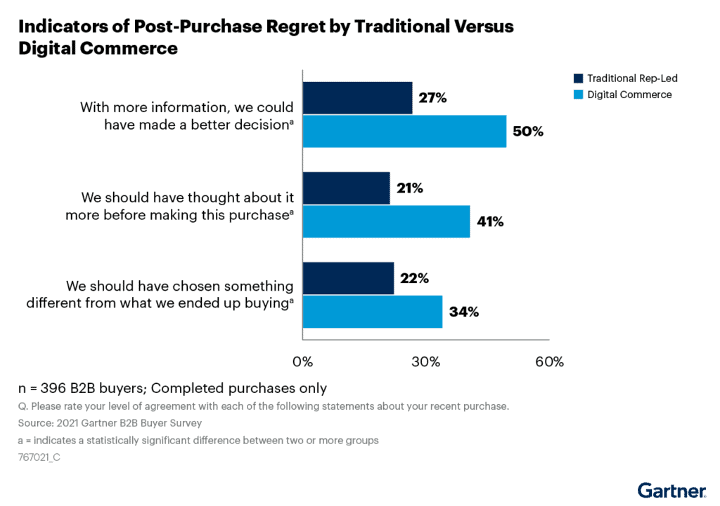There’s an old saying that states that the best way to avoid buyer’s remorse is not to buy something right away. If you still yearn for it, days/weeks/months later, you’ll be less inclined to regret your decision when you buy it. Unfortunately, when it comes to B2B purchases, it’s not that simple to avoid buyer’s remorse.
What makes buyer’s remorse different from B2B is that in addition to large purchasing costs, it’s also your name, your career, on the line. When it comes to large investments, pushback is inevitable – so doubt is inevitable.
In a 2021 Gartner survey where two-thirds of the B2B buyers spent over $100,000 on a purchase:
- 34% think they should have chosen something else
- 41% wish they had taken more time to make a final decision
- 50% agree that a better decision could have been made with more information
In the above model, the numbers are shaved slightly when you work through a more traditional sales representative-led journey. But they are still high when we are talking about an investment of six figures or more.
What’s even more perplexing about these figures is that this level of buyer’s remorse is avoidable!
There are five key advisory-driven milestones that cover most issues that cause regret:
1. Build a “Guiding Principles” document.
Guiding Principles act as a set of rules to keep you in check during your buying journey. These principles are set up to align expectations for everyone during the process. For example, “we will not overdesign, or under design” can be one of the principles. Every decision made must align to at least one of these values or its out. Make at least three and no more than six depending on the scope of the initiative. Remember, keep it simple, but in line with your organization’s vision.
2. Define a realistic budget.
Just like when you buy a home or car, you have a maximum number that you can afford. But how many times has an agent shown you something outside your budget but looks and feels amazing? Do not get distracted by the shiny thing! Know your budget. Stick to your budget. And most importantly, align it with your Guiding Principles.
3. Build “x-haves” lists.
Create a list of the required incumbent solution’s features. When new vendors present their features, sort them into “must-have” or “nice-to-have” buckets. This will limit you from over-designing and under-delivering. Ask yourself, will we use this and why? What does it really solve if we do? What would it benefit? Or – why can’t we function without it?
4. Step outside the vacuum.
One of the biggest mistakes buying committees can make is not getting input from the employees who will actually use the new solution. Including business units in the decision have many benefits. One is that it will help them better understand how it will improve their day-to-day. It will expedite their buy-in and adoption of the new solution. Another is that running the “x-have” lists with them will build a strong use case for the final decision.
5. Use your “Audit Trail” to get leadership approval.
Milestones one through four are combined to form an Audit Trail. This is the information you’ll use to get leadership on board with your decision. Guiding principles have kept the buying committee in check. The budget is realistic. The requirements are sorted and tied back to the Guiding Principles. And most importantly, BUs that will be affected by the new solution has given their input.
Buyer’s remorse is avoidable. Sure, you’ll have unknown factors and risks in any buying decision. But if you work with an advisor to hit the milestones above, the gaps that typically cause regret will be covered.


.png)



